MAN OF ACTION -- Join Jamie and Sandy as they present forum member John McGregor's submission about your first trip to a shooting range. John is the cohost of the Gunfighter Cast and an instructor for Sig Sauer, so you are in for a real treat here!
Forum member John Mc, AKA John McGregor of the Gunfighter Cast, joins us today with his tips on taking your first trip to a trip to a firing range - from what to bring, what to expect, picking a weapon (if you don't have your own), how to behave on the range and more. This is a lot of great information from a fantastically experienced presenter.
John left us with some fantastic show notes that he wanted to leave with everyone!
Listen to the podcast itself, with Sandy and Jamie's commentary, at the bottom of this post.
Trip to a typical American commercial gun range to shoot a handgun.
Introduction: John McGregor, Retired Law Enforcement Officer, Firearms Instructor, Adjunct Instructor for Sig Sauer Academy since 2003, host of Gunfighter Cast, a podcast which discusses firearms equipment and training as it relates to self-defense from a military, law enforcement and responsible citizen perspective. www.gunfightercast.com
Manage expectations. Going to a firearms range and renting a pistol is not going to make you an expert shooter, anymore than renting a sportscar is going to make you a race car driver.
If you want to learn to how to be a proficient shooter, consider taking a class. One such class that I teach at Sig Sauer Academy is an 8 hour class called Handgun Orientation.
https://www.sigsaueracademy.com/productdisplay/handgun-orientation-handgun-101
In that class we cover:
- Firearms Safety
- Different type of handguns and how to load, unload and make sure they are empty
- Foundational shooting techniques
- Ammunition and how it works
- Range drills
- Firearms maintenance
- Firearms related laws including Use of Force
There is no way all that can be covered in one brief podcast episode. Think of this episode more like a typical trip to the bowling alley. You are not trying to become a professional bowler, you just want to have some fun and try your skill at hitting something across the room without embarrassing yourself.
Find a commercial firearms range in your area. Just like most businesses it should be clean and well lit. If its dark and dirty, find somewhere else.
TIP ONE: Plan your visit for early in the day during the week. Ranges are typically busiest on during the evenings and on weekends. By going to the range when it is not so busy, you may get some extra attention and not be rushed in a sea of customers.
TIP TWO: Bring a friend. Unfortunately, people have attempted suicide at commercial gun ranges. If you show up alone with no previous firearms experience or concealed carry permit, the range may not let you shoot by yourself.
TIP THREE: Assuming you don't have a handgun of your own, you will need to rent one. Rather than trying to make sense of the 20-30 pistols in the case, ask to shoot a Glock 17.
Why not a Walther PPK or a Walther P99? A Walther PPK has actually harder to shoot because of its smaller size. It also has a slightly more complicated operating system than the Glock 17. A P99 operates similarly to the Glock but it is not as universally available. If you ask for a Glock 17, 99% of the ranges that rent pistols will have one. The Glock has no external safety levers or decocking levers to figure out. And by choosing a Glock 17 you are also choosing your caliber, which in this case is 9mm. Some pistols come in multiple calibers. A Glock 17 is not my personal favorite, but by choosing a Glock 17 you are avoiding having to make a lot of choices and appear indecisive. As far as a James Bond tie in, you only have to look back to the last James Bond movie, Skyfall. Bond uses one that he takes from a bad guy to capture Silva, and Mallory uses one during the attack at the public inquiry.
The paperwork is the next step. Bring identification. Plan on answering questions that will confirm you can legally possess a firearm, such as questions about your criminal history, any active court orders, or any history of drug use. They may ask you about your experience with firearms. Be honest. That will give them the opportunity to give you additional guidance. Plus they will be assessing your skills anyway and will be able to tell if you have no idea what you are doing pretty quickly.
Plan on reading and signing a Release of Liability and Assumption of Risk waiver.
Plan on reading the a list of the range's firearm safety rules. There will be many. Take the time to read them and ask questions if you have them.
Of all the rules, there are two concepts that if followed will keep you from hurting yourself, hurting someone else, or getting yelled at because you are doing something unsafe. Muzzle Management and Trigger Finger Discipline.
Muzzle Management: Keep your muzzle pointed in a safe direction at all times. The muzzle is the end of the firearm where the bullet comes out of. A safe direction is a direction where, if the pistol were to fire, there would be no chance of personal injury and the minimal amount of property damage. Imagine the clerk behind the counter hands you the Glock 17 you requested. If you hold the pistol like you have seen hundreds of time on TV and in movies you are probably standing across the counter pointing the pistol at the clerk. That is not acceptable. Before you touch a firearm, think about where the safest direction is to keep the muzzle pointed. In the retail area, it will probably be down. On the range, the pistol must stay pointed down range, the wall behind the targets.
Trigger Finger Discipline: When you hold a pistol, your thumb will be on one side of the grip. Your middle, ring and pinky fingers will wrap around the other side of the grip. Your index finger will naturally want to rest on the trigger. This is how the engineers designed the firearm to feel comfortable. Resist the urge to touch the trigger and instead touch your index finger to the side of the pistol above the trigger. Anytime the pistol is in your hand and you are not firing the pistol, the index finger should be pressed into the side of the pistol above the trigger.
The clerk will show you your pistol. Other than the trigger there are only two controls you will want to be familiar with. On the left side of frame by the bottom of the guard that protects the trigger is a button you press when you want to remove the magazine from the pistol. On the left side toward the back of the slide is a slide catch lever. You can use it to lock the slide to manually lock the slide to the rear. The magazines should lock the slide to the rear automatically when they are empty.
The clerk will show you how to load your magazine. The magazine is what holds your ammunition for insertion into the pistol. If you look at your ammunition, you will see that the front is round and the back is flat. If you look at the magazine you will see that the front is round and the back is flat. Those are clues which will tell you which direction to load your ammunition into your magazine.
The clerk will show you how to get your pistol and ammunition onto the range. Commercial ranges in my area give you a plastic tote which will contain the pistol and ammunition with which to carry your gear to the range.
Besides renting a firearm and purchasing your ammuntion, you will have to rent or purchase eye protection and hearing protection, and purchase targets. Once you have made your purchases, you are ready to head to the range.
TIP FOUR: Put your eye and ear protection on in the sales area before heading into the range. Someone may be there before you already shooting.
Find your assigned lane. Your lane should consist of side walls and a table for your gear. Take your pistol and place it on the table so that the muzzle faces away from you pointing towards the targets. This is the downrange direction.
Attach your target and place it at about three yards away. It will seem close, but I will describe a drill that you can use to start your session at this distance.
Before you load the pistol, experiment with some foundational shooting techniques. Put two hands on the pistol and point it down range.
Stance. Just stand comfortably. A common mistake for first time shooters is to lean back away from the pistol. They are trying to get as far away from the pistol as possible. This will lead you to lose your balance with the pistol is fired.
Grip. There are at least a couple. For your first trip to the range, just make sure that both of your thumbs are on the same side of the pistol. If you have one thumb on each side of the pistol, when you fire the pistol the slide will come back and strike the top thumb. It is a self correcting error, because you will not want to do it again.
Sight alignment. Look at the front site. There is a dot on it. Look at the rear sight. It is a U shaped notch. Imagine you drew a horizontal line across the top of the rear sight. You now have a small square/rectangle. Think of that square/rectangle as a TV screen. Hold the pistol so you can see the front site dot on your rear sight "TV Screen".
Sight picture. Keeping the front site dot on the rear sight TV screen, move the pistol until the dot is over the area where you want to hit on the target. Focus on the dot, not the target or the rear sight.
Move your index finger to touch the trigger. Smoothly press it to the rear. If done properly the front site should still be visible. It is ok if the front site is moving around a little. We all have a natural arc of movement. Repeat pressing the trigger a few times. Place the pistol back down on the table in front of you, muzzle down range.
Load your magazine with 5 rounds. The magazine will hold more rounds, but by starting out with just 5 rounds it reducing the chance of fatigue, both from loading the magazine and from shooting the pistol.
Pick up the pistol with the hand you pull the trigger with. Remember muzzle management and trigger finger discipline. You are about to load your pistol Pick up your magazine in the other hand. Insert the magazine into the grip of the pistol until it clicks. Try to pull on the bottom of the magazine to see if it comes out. If it does not it is properly seated. If it comes out, try again. With the hand you used to insert the magazine, grab the back of the slide, right below the rear sight. Pull back as far as it will go and release. Don't try to help the slide forward. Just let it go. Your pistol is now loaded.
Don't worry too much about stance and grip. Just make sure you are balanced and both thumbs are on the same side of the pistol.
Align the sights and float the dot over the center of your target. Find the trigger with your index finger and smoothly press it back until the pistol fires. When the pistol fires, take your finger off the trigger and place it on side of the pistol above the trigger. When you are ready to continue, float the dot and smoothly press the trigger repeatedly until the slide stays locked in the rearward position and the pistol will no longer fire. Press the magazine release on the left side of the pistol by the bottom of the trigger guard to remove the magazine from the pistol. Place the pistol on the table in front of you with the muzzle pointing down range.
Other drills: One hole drill, longer distance, take your time.
When you have fired your last round of ammunition for the day, leave the slide of the pistol locked to the rear, and return your equipment to the rental counter in the same manner you brought it out to the range. Keep your targets to show your friends.
Pay the clerk for your purchases and rentals.
LAST TIP: Way back when you were filling out paperwork, the range probably kept your ID. Make sure you don't leave without it.

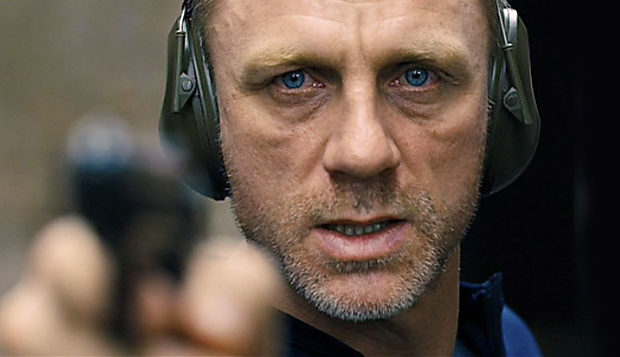


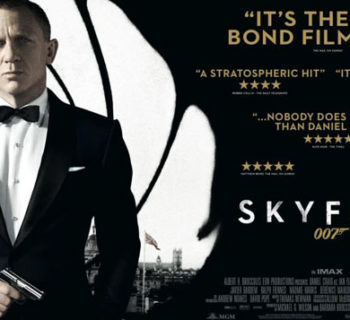
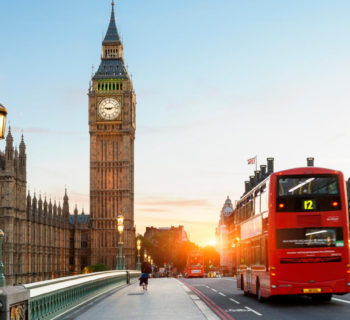

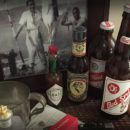
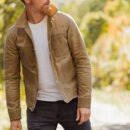


Top 5 Rejected James Bond Theme Songs
The "No Time To Die" Review